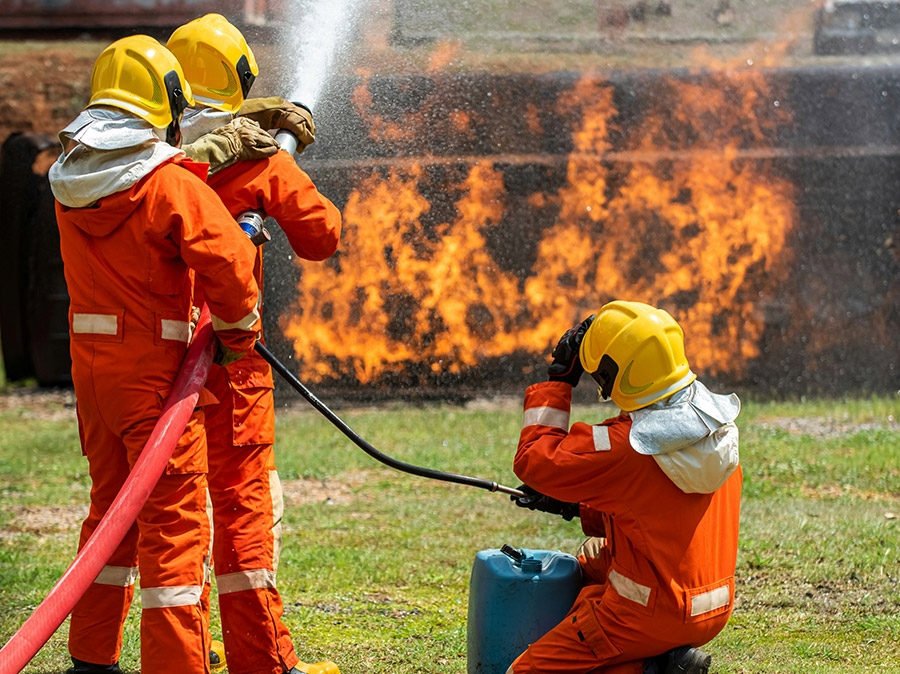Tags
HOW TO BECOME A SUPERYACHT STEWARD/ESS: A COMPLETE GUIDE.
The world of superyachts offers an exciting and sometimes glamorous career. Working as a superyacht steward/ess is an incredible way to explore the world, meet fascinating people, and earn a good salary.
This career is not only rewarding in terms of experience but also provides opportunities for long-term growth. If you’re interested in becoming a superyacht steward/ess, here’s everything you need to know about the job, the responsibilities, and how to get started.
What is a Superyacht Stewardess?
A superyacht stewardess is responsible for providing high-end hospitality service to the yacht's guests. This role involves maintaining the yacht’s interior to an exceptionally high standard. Serving food and drinks, organising guest activities, and ensuring that guests have an unforgettable experience. As a stewardess, your tasks can vary from cleaning cabins to - setting up elaborate dining arrangements and catering to guest requests.
The Key Responsibilities of a Superyacht Stewardess
- Superyacht stewardesses are responsible for maintaining the yacht's luxurious interior and providing world-class service. Some of the key tasks include:
- Cabin Preparation and Cleaning: Stewardess/es keep guest cabins and common areas pristine. This involves making beds, tidying up, polishing, and ensuring everything is spotless at all times.
- Guest Services: Stewardess/es attend to the guests, make and serving drinks, serve meals, and respond to guests needs & requests. You’ll need to anticipate their needs and ensure they have an enjoyable, luxurious experience throughout their stay.
- Table Setting and Fine Dining Service: Setting up tables and serving meals with the precision of a fine-dining restaurant is a key part of the job. You may be involved in elaborate event setups, themed evenings, and even formal dining arrangements.
- Laundry and Wardrobe Management: Stewardesses take care of all the laundry and ironing of both guest and crew clothing. Attention to detail is key to maintaining the high standards of the yacht.
- Interior Maintenance: You’ll be responsible for keeping the yacht's interior looking immaculate. This includes caring for delicate items like artwork, ensuring décor is flawless, and taking care of plants or flowers.
- Stock and Inventory: Stewardesses must ensure the yacht is well-stocked with supplies such as toiletries, drinks, linens, and guest produce and amenities. You’ll often manage inventories and work closely with suppliers to order more when needed.
- Event and Activity Planning: From organizing onboard parties to helping with water sports or beach setups, stewardesses often assist with guest entertainment and activities.
How to Become a Superyacht Stewardess
While becoming a stewardess on a superyacht is competitive, with the right attitude, training, and preparation, it’s possible to land your first job. Here’s how:
1. Meet the Basic Requirements - Before embarking on your career, make sure you meet the general requirements for working on superyachts:
- Age: You must be at least 18 years old to work on a yacht.
- Passport: You’ll need a valid passport, as superyacht crew often travel internationally.
- Physically Fit and Healthy: The role can be physically demanding, and you’ll be required to pass a ENG1 Medical Certificate, which confirms you are fit to work at sea.
2. Complete the Necessary Certifications - To work on a superyacht, there are a few mandatory certifications and training courses that you need to complete:
- STCW (Standards of Training, Certification, and Watchkeeping): This is the essential safety certification required for all yacht crew. It includes courses in:
Personal safety and social responsibilities - First aid
- Sea survival
- Firefighting
- Security awareness
- The STCW course typically lasts 5-7 days, and every aspiring yacht crew member must have this certificate.
- ENG1 Medical Certificate: The ENG1 is a medical exam that ensures you are fit to work on a yacht. It covers both physical and mental health and is a mandatory requirement for most yacht jobs.
3. Develop the Necessary Skills - While formal education is not required to become a superyacht stewardess, certain skills can make you more attractive to potential employers:
- Hospitality Experience: A background in hospitality, especially in hotels, restaurants, or private estates, will be highly valuable. The level of service required on superyachts is similar to that of five-star resorts, so any experience in customer-facing roles is beneficial.
- Attention to Detail: As a stewardess, maintaining the yacht’s luxury standards is critical. An eye for detail and the ability to perform tasks to perfection, such as table setting, cleaning, and guest service, are key qualities for this role.
- Communication Skills: The ability to communicate effectively with guests and fellow crew members is essential. Understanding guest preferences and anticipating their needs is a big part of the job.
- Multi-tasking and Organization: Stewardesses must juggle multiple tasks simultaneously—whether it’s preparing cabins, serving meals, or responding to guest requests. Being organized and staying calm under pressure will help you succeed.
4. Register with Crew Agencies - Once you have the necessary certifications and skills, it’s time to begin job hunting. Networking is crucial in the yachting industry, and one of the best ways to get your name out there is by registering with yacht crew agencies such as Venture Yacht Crew.
- Online Job Boards: Websites like Yotspot post jobs for stewardesses, which can help you find opportunities as they arise.
- Dockwalking: Similar to deckhands, stewardesses can benefit from “dockwalking.” This involves visiting marinas and introducing yourself to yachts that are docked. You may be able to pick up daywork or temporary jobs, which can lead to a permanent position.
5. Build a Standout CV - Your CV is your first impression, so it should be professional, concise, and tailored to the yacht industry. Make sure to include:
- Personal Information: Include your name, contact details, nationality, and passport information.
- Qualifications: Clearly list your STCW certification, ENG1 medical, and any other relevant courses or qualifications.
- Experience: Highlight your experience in hospitality, housekeeping, or guest service. If you’ve done any daywork on yachts, include this.
- Skills: Emphasize any relevant skills, such as table service, cocktail making, flower arranging, or language abilities.
- References: Provide at least one reference from a previous employer or daywork captain.
6. Stay Persistent and Flexible - The superyacht industry can be competitive, and landing your first job might take time. Be persistent in your job search, keep improving your skills, and remain open to taking daywork or temporary jobs to gain experience. Sometimes it’s all about being in the right place at the right time, so staying flexible is essential.
What Life is Like as a Superyacht Stewardess
While working as a stewardess on a superyacht can seem glamorous, the reality is that it’s often demanding and fast-paced. Here’s what to expect:
- Long Hours: When guests are onboard, you’ll often work long hours— However, during downtime or when the yacht is not in use, you’ll have more relaxed periods.
- Living in Close Quarters: You’ll be living on the yacht with other crew members, which means you’ll be sharing cabins and communal spaces. You’ll need to get along well with others and be comfortable in close quarters.
- Attention to Detail is Key: Everything on a superyacht is expected to be perfect. Whether it’s a carefully arranged fruit plate or immaculately cleaned glassware, your attention to detail will define the guest experience.
- Travel: One of the most exciting parts of the job is the opportunity to travel the world. Superyachts often sail to luxurious destinations, from the Mediterranean in the summer to the Caribbean in the winter.
- Career Progression: With time and experience, you can move up the ranks. A junior stewardess can become a senior stewardess, and eventually, the Chief Stewardess, who manages the entire interior team and oversees guest services.
Conclusion
Becoming a superyacht stewardess is an exciting opportunity for those who love hospitality, adventure, and travel. While the job can be demanding, it offers a unique lifestyle filled with luxury, travel to exotic destinations, and the chance to meet high-profile individuals. If you have a passion for service, an eye for detail, and a love for travel, this could be the perfect career for you. With the right certifications, networking, and perseverance, you’ll be on your way to becoming a superyacht stewardess in no time.
HOW TO BECOME A SUPERYACHT DECKHAND
Working as a deckhand offers the opportunity to meet interesting people, earn a good salary and travel to stunning destinations. However, becoming a superyacht deckhand requires preparation, a strong work ethic, and the right attitude. If you're considering this exciting career path, this guide will walk you through how to become a deckhand and what the role involves.
What is a superyacht deckhand?
A superyacht deckhand is a key crew member responsible for the maintenance and operation of the yacht’s exterior. As the first point of contact for guests when they board, deckhands play an essential role in maintaining the luxury standards of the vessel. This entry-level position is physically demanding and requires long hours, but it offers incredible opportunities for travel, adventure, and career growth within the superyacht industry.

Key responsibilities of a superyacht deckhand.
Deckhands have various responsibilities that revolve around maintaining the vessel's exterior, assisting in navigation, and ensuring safety. Some of the primary duties include:
• Exterior Cleaning and Maintenance: Deckhands ensure the yacht's exterior stays immaculate. This includes washing the deck, polishing metalwork, and cleaning windows. Attention to detail is key, as superyachts must remain spotless.
• Handling Mooring Lines: During docking and departure, deckhands are responsible for handling lines and securing the yacht.
• Operating Tenders and Water Sports Equipment: Deckhands often manage tenders (small boats used to transport guests) and help with water sports activities like jet skis, paddleboards, and diving gear.
• Safety Checks and Procedures: Ensuring the yacht adheres to safety protocols is crucial. Deckhands are trained to assist in emergency situations, perform basic maintenance on safety equipment, and know how to respond to accidents on board.
• Assisting Guests: Whether it’s helping guests on and off the yacht, setting up deck chairs, or facilitating water sports activities, deckhands ensure that guests have a luxurious and enjoyable experience.
• Watchkeeping: When the yacht is at sea, deckhands often assist in keeping watch, monitoring the yacht’s surroundings for safety, and helping with navigation.
• General Maintenance: Minor repairs and maintenance, such as painting or repairing lines, are common duties that ensure the yacht remains in top condition.
• And taking out the rubbish!
How to become a superyacht deckhand.
Now that you understand what the role entails, let’s dive into how you can land your first job as a superyacht deckhand.

1. Meet the basic requirements.
Before you start applying for jobs, ensure you meet the basic prerequisites:
Age: You to be at least 18 years old.
Passport: You’ll need a valid passport, as you’ll be travelling internationally.
Fit and Healthy: The job is physically demanding, so you need to be in good physical shape. You will also to pass a medical examination known as the ENG1, which confirms your fitness to work at sea.
2. Complete the required certifications.
To work legally as a deckhand on superyachts, you’ll need a few essential certifications. These courses will equip you with the skills to handle emergencies and understand the basics of life at sea.
STCW (Standards of Training, Certification, and Watchkeeping): This is the mandatory training required for all crew members working on yachts over 24 meters in length. It typically covers:
- Firefighting
- First aid
- Sea survival
- Personal safety and social responsibilities
- Security awareness
The STCW course is generally completed in 5-7 days and is a non-negotiable requirement for working on yachts.
ENG1 Medical Certificate: This certificate is proof that you are physically fit to work at sea. You’ll need to schedule a medical examination with an approved doctor who specializes in maritime health.
3. Gain relevant skills.
While no formal education is required to become a deckhand, certain skills and experiences can make you stand out:
• Boating Experience: Experience handling boats or operating water sports equipment will be highly beneficial. If you don’t have any boating experience, consider taking courses such as the Powerboat Level 2 certification, which teaches you how to operate small powerboats.
• Practical Skills: Basic knowledge of mechanical work, painting, or carpentry can come in handy when maintaining the yacht.
• Hospitality and Customer Service: If you’ve worked in a customer-facing role, such as in hotels, restaurants, or hospitality, your skills in dealing with guests can be a valuable asset.
4. Network and register with crew agencies.
Once you’re certified, it’s time to start job hunting. The superyacht industry relies heavily on networking, so it’s essential to get your name out there.
Crew Agencies: There are several reputable yacht crew agencies that can help place you on a vessel. Make sure you look for ones certified by the MCA like Venture Yacht Crew.
Dockwalking: A traditional way to get your foot in the door is through “dockwalking,” which involves visiting marinas and introducing yourself to crew members or yacht captains in person. You may be able to pick up daywork (temporary jobs) which can lead to full-time positions. When dockwalking, make sure to dress professionally, bring copies of your CV, and be ready to answer questions.
5. Prepare a strong CV.
We have a CV template on our website which is free and easy to use
Your yacht CV should be clear, concise, and highlight relevant skills. Here are some tips to make your CV stand out:
• Personal Information: Include your name, a headshot photo, contact information, and nationality.
• Qualifications: List your STCW, ENG1, and any other certifications.
• Relevant Experience: Mention any previous roles in boating, maintenance, or customer service.
• References: If you’ve done daywork or part-time roles, include references who can vouch for your work ethic and abilities.
6. Stay persistent and patient.
Getting your first deckhand job may take time, but persistence is key. Keep networking, applying for jobs, and gaining experience wherever possible. Seasonal work often presents more opportunities, so stay flexible and ready to move at a moment's notice.
The realities of working as a deckhand.
While the superyacht industry may seem glamorous, life as a deckhand is not without its challenges. Long hours, physical labour, and time away from family and friends are all part of the job. Additionally, the standard of work expected is extremely high, as you’re catering to wealthy and demanding guests. Here are some factors to consider:
Work-Life Balance: You’ll often work long hours and may not have much free time during guest trips. Off-seasons, however, may offer time to relax or travel.
Tight Quarters: You’ll likely be living in shared cabins with other crew members, so you need to be comfortable working in close quarters.
Seasonal Nature: Many deckhand jobs are seasonal, with more opportunities during peak yachting seasons (summer in the Mediterranean, winter in the Caribbean).
Career Progression: With time and experience, you can move up the ranks to positions like Bosun (lead deckhand) or even Officer. Continuing education and gaining more certifications (e.g., Yachtmaster) can open doors to more advanced roles.
Conclusion.
Becoming a superyacht deckhand is a fantastic way to start your career in the yachting industry. It offers an exciting lifestyle with the chance to see the world while working on some of the most luxurious vessels. If you’re hardworking, eager to learn, and passionate about the sea, a career as a deckhand could be the perfect fit. Follow the steps above to get started, and with persistence, you’ll soon be on your way to living the yachtie life.








